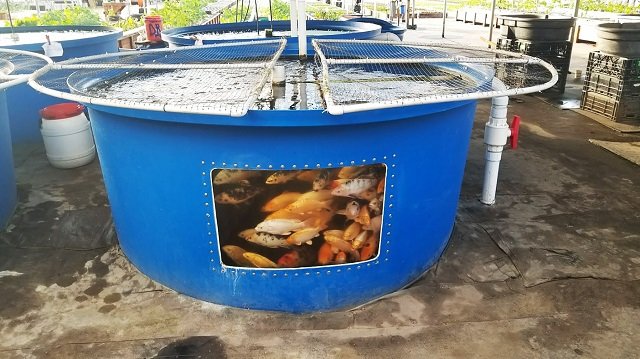
Aquaponics, a symbiotic relationship between aquaculture and hydroponics, has emerged as a sustainable method of food production with the potential to address various environmental and economic challenges. By combining fish farming with plant cultivation in a closed-loop system, aquaponics can reduce water consumption, minimize waste, and produce high-quality, nutrient-rich food.
A study published by researchers from the University of Thessaly (Greece) and Aristotle University of Thessaloniki (Greece) in the journal Scientia Horticulturae aimed to fill knowledge gaps in scaling up from lab-scale systems to larger-scale decoupled aquaponics, offering a comprehensive understanding of system productivity and the efficiency of water and fertilizer use.
Aquaponics: A Sustainable Alternative
- 1 Aquaponics: A Sustainable Alternative
- 2 The Evolution of Aquaponic Systems: From CAP to DCAP
- 3 Comparing Coupled, Decoupled Aquaponics, and Hydroponics
- 4 Decoupled Aquaponics: A Higher-Yielding System
- 5 Water and Fertilizer Efficiency
- 6 The Future of Aquaponics: Decoupled Systems
- 7 Entradas relacionadas:
Aquaponics offers a promising solution to the environmental challenges associated with hydroponics by integrating recirculating aquaculture systems (RAS) with hydroponics in a symbiotic environment. In this system, fish waste provides organic nutrients for plants, reducing the need for synthetic fertilizers. In turn, the plants help filter and purify the water, which is recirculated back to the fish tanks. This closed-loop system not only conserves water but also recycles nutrients, aligning with the principles of a circular economy.
Most of the nutrients in aquaponics are organic, derived from fish waste, which contrasts with the inorganic nutrients typically used in conventional hydroponics. Some researchers argue that organic nutrients are superior for plant growth and that aquaponics offers additional benefits, such as savings on fertilizers. The reduced or eliminated need for chemical fertilizers in aquaponics not only enhances its environmental sustainability but also supports the production of healthier, more naturally growing crops.
The Evolution of Aquaponic Systems: From CAP to DCAP
Traditional aquaponic systems, known as coupled aquaponic systems (CAP), feature a single water circulation loop where nutrients from fish waste flow directly into the hydroponic growing medium. While CAP systems are effective at recycling nutrients, they have faced criticism for producing lower yields compared to conventional hydroponics. The lower concentration of nutrients in aquaponic solutions and high pH levels in CAP systems are key factors contributing to reduced plant yields.
To address these challenges, the aquaponics industry has evolved towards decoupled aquaponic systems (DCAP), where nutrient concentrations and water quality parameters can be adjusted independently. This allows for more intensive fish and plant production, comparable to conventional aquaculture and hydroponic systems. Although DCAP is a relatively new approach, initial results are promising, particularly in terms of crop yield.
Studies have shown that DCAP systems can achieve yields similar to or even better than traditional hydroponics for various crops. For example, research on tomato plants has demonstrated comparable yields in DCAP systems to hydroponics, and some studies report even better results for lettuce, basil, and mizuna. Additionally, DCAP plants have shown higher photosynthetic capacity, indicating more efficient resource use and the potential for greater productivity.
Comparing Coupled, Decoupled Aquaponics, and Hydroponics
Current research focuses on comparing the performance of hydroponics, coupled aquaponics, and decoupled aquaponics under the same environmental conditions. Conducted at the Pilot Greenhouse Park facilities at the University of Thessaly in Greece, this study is the first comprehensive examination of these systems on a large scale using perlite as a substrate for plant growth.
Stay Always Informed
Join our communities to instantly receive the most important news, reports, and analysis from the aquaculture industry.
The study involved cultivating two leafy crops (basil and parsley) and two fruit crops (tomato and cucumber) in three different treatments: coupled aquaponics, decoupled aquaponics, and conventional hydroponics. Researchers measured yield (both fish and plant), water and fertilizer use, and nutrient efficiency to assess the productivity and sustainability of each system.
Decoupled Aquaponics: A Higher-Yielding System
The experiment results demonstrated the superiority of decoupled aquaponics in terms of crop yield. Plants grown in DCAP consistently outperformed those in CAP and HP, with yield increases ranging from 8% to 72%. This suggests that the decoupled system provides a more optimal environment for plant growth and development.
Water and Fertilizer Efficiency
In terms of water and fertilizer use efficiency, the CAP treatment that did not receive additional fertilizers showed the highest efficiency. However, DCAP still outperformed HP in terms of water and fertilizer use. This indicates that decoupled aquaponics can be a more sustainable option, reducing the need for external inputs while maintaining high productivity.
The Future of Aquaponics: Decoupled Systems
The findings of this study highlight the significant advantages of decoupled aquaponics over coupled systems. The ability to independently control the aquaculture and hydroponic units provides greater flexibility and adaptability, facilitating system scaling and optimization for specific crops and environmental conditions. As the demand for sustainable food production continues to grow, decoupled aquaponics is poised to play a crucial role in shaping the future of agriculture.
Contact
N Katsoulas
University of Thessaly, Department of Agriculture Crop Production and Rural Environment
Fytokou Str., 38446 Volos, Greece
Email: nkatsoul@uth.gr
Reference
Aslanidou, M., Elvanidi, A., Mourantian, A., Levizou, E., Mente, E., & Katsoulas, N. (2024). Evaluation of productivity and efficiency of a large-scale coupled or decoupled aquaponic system. Scientia Horticulturae, 337, 113552. https://doi.org/10.1016/j.scienta.2024.113552
Editor at the digital magazine AquaHoy. He holds a degree in Aquaculture Biology from the National University of Santa (UNS) and a Master’s degree in Science and Innovation Management from the Polytechnic University of Valencia, with postgraduate diplomas in Business Innovation and Innovation Management. He possesses extensive experience in the aquaculture and fisheries sector, having led the Fisheries Innovation Unit of the National Program for Innovation in Fisheries and Aquaculture (PNIPA). He has served as a senior consultant in technology watch, an innovation project formulator and advisor, and a lecturer at UNS. He is a member of the Peruvian College of Biologists and was recognized by the World Aquaculture Society (WAS) in 2016 for his contribution to aquaculture.




